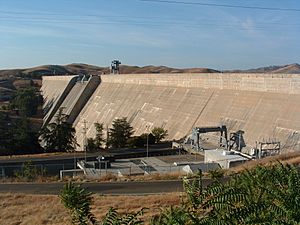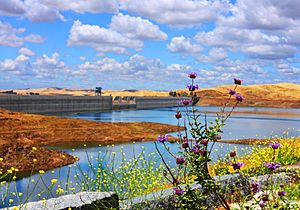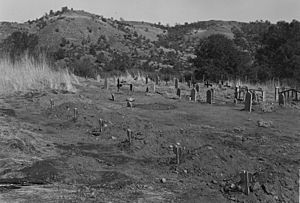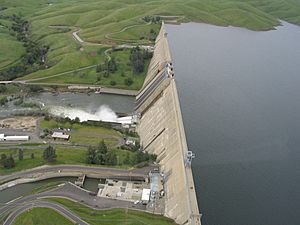Friant Dam facts for kids
Quick facts for kids Friant Dam |
|
|---|---|
 |
|
| Country | United States |
| Location | Madera/Fresno Counties, California |
| Coordinates | 37°00′02″N 119°42′19″W / 37.00056°N 119.70528°W |
| Construction began | 1939 |
| Opening date | 1942 |
| Owner(s) | Central Valley Project |
| Dam and spillways | |
| Type of dam | Concrete gravity |
| Impounds | San Joaquin River |
| Height | 319 ft (97 m) |
| Length | 3,488 ft (1,063 m) |
| Width (base) | 267 ft (81 m) |
| Spillway type | Gated overflow, 1 center flotation drum gate, 2 obermeyer pneumaticly actuated gates. |
| Spillway capacity | 83,000 cu ft/s (2,400 m3/s) |
| Reservoir | |
| Creates | Millerton Lake |
| Total capacity | 520,528 acre⋅ft (642,062 dam3) |
| Inactive capacity | 120,000 acre⋅ft (150,000 dam3) |
| Catchment area | 1,638 sq mi (4,240 km2) |
| Surface area | 4,900 acres (2,000 ha) |
| Power station | |
| Turbines | 1x 15 MW, 1x 8 MW, 1x 2 MW |
| Installed capacity | 25 MW |
| Annual generation | 81,409,000 KWh |
The Friant Dam is a large concrete dam on the San Joaquin River in central California, United States. It sits on the border of Fresno and Madera Counties. This dam was built between 1937 and 1942. Its main job is to provide water for farming in the southern San Joaquin Valley. The dam creates Millerton Lake, a big reservoir about 15 miles (24 km) north of Fresno.
Contents
About the Dam's History
The area where Friant Dam and Millerton Lake are now was once home to the old town of Millerton. This town was the first county seat for Fresno County. In 1880, the first dam on the San Joaquin River was built near the current dam site. It was made of rock and was 800-foot (240 m) long and 6-foot (1.8 m) tall. This early dam was meant to help water 250,000 acres (100,000 ha) of farmland. However, floods destroyed it just two years later.
Planning the Central Valley Project
The idea for Friant Dam came about in the 1930s. It was planned as a key part of the Central Valley Project (CVP). The CVP was a huge government plan to build many dams and canals. These would manage water from rivers in the Central Valley. The main goal was to supply water for farms. Other goals included controlling floods, providing water for cities, and making electricity.
The U.S. government approved the CVP in 1935. Money for Friant Dam, about $20 million, came from a special law in 1935. This law helped create jobs during the Great Depression.
Starting Construction
Workers began surveying the dam site in late 1935. By January 1938, a camp was set up near Friant for the dam workers. Many people were looking for jobs during the Great Depression. So, lots of job seekers came to the Friant Dam site. Some even had to live in nearby cities. On November 5, 1939, over 50,000 people came to celebrate the start of the dam's construction. It was one of the biggest celebrations in the San Joaquin Valley's history.
How Friant Dam Was Built
Building Friant Dam started with blasting and digging. Workers removed over 1,200,000 cubic yards (920,000 m3) of loose dirt and rock to reach solid ground. Before pouring concrete, they filled 725 holes and cracks in the bedrock with a special mixture called grout. This made the foundation very strong.
The concrete for the dam was made from sand and gravel. These materials were dug up from the San Joaquin River floodplain, about 3 miles (4.8 km) below the dam. Interestingly, workers found over 5,400 ounces (150 kg) of placer gold during the digging. This gold was worth $176,000 at that time. A special train line brought these materials to a concrete mixing plant. This plant could make up to 6,000 cubic yards (4,600 m3) of concrete every hour. In July 1940, the San Joaquin River was moved into a wooden channel. This allowed workers to start building the dam's foundations.
Pouring the Concrete
On July 29, 1940, the first concrete was poured for the dam's main wall. The dam was built in large square sections, each 50 feet (15 m) wide. Concrete was moved using a huge steel structure 210 feet (64 m) high and 2,200 feet (670 m) long. Small railcars on this structure carried buckets of concrete from the mixing plant. Two large cranes then lifted the buckets and poured the concrete into the forms.
In the summer of 1941, about 1,500 people were working on the dam. In August, they set a record by placing 228,000 cubic yards (174,000 m3) of concrete in one month.
During the dam's construction, several Native American burial sites were found. The graves were carefully moved and re-buried in new locations.
Finishing the Dam
Workers rushed to finish the dam's main wall. This was because the War Production Board (WPB) decided to use resources for U.S. military efforts in World War II. The dam's main structure was completed on June 16, 1942. This was less than two years after the first concrete was poured. However, the spillway gates, water release valves, and the two irrigation canals were not finished due to the WPB's order.
The war did not completely stop construction. Less than a year later, the WPB decided that finishing the Madera Canal and installing valves at Friant Dam was important for wartime food production. This allowed some construction to continue. Two control valves were borrowed from Hoover Dam. This allowed the river outlets to be closed, and Millerton Lake began to fill on February 21, 1944.
Work on the Madera Canal was finished in 1945. This canal is the smaller of the two that Friant Dam supplies. Water flowed through its entire length for the first time on June 10, 1945. Irrigation deliveries began a month later. The larger canal, the Friant-Kern Canal, was completed four years later.
California Governor Earl Warren officially opened the dam on July 9, 1949. He said that the water from Friant Dam would help the San Joaquin Valley become a "modern Eden." More than three thousand people attended the ceremony. Water was released into the partly finished Friant-Kern Canal for the first time that day.
Secretary of the Interior Harold Ickes spoke at the dedication:
[The dam is] but a lifeline to preserve and enhance our American civilization. This is a line of creation, built to unlock the fertility of the rich soil, to resist drought, to overcome floods, to provide outdoor recreation, and to generate cheap power that will improve the living conditions of millions of our citizens."
How the Dam is Used
Friant Dam's main job is to catch the changing water flows of the San Joaquin River. Then, it sends this water for farming through two canals: the Friant-Kern Canal and the Madera Canal. The Friant-Kern Canal is 151.8 mi (244.3 km) long. It runs south from the dam to the Kern River near Bakersfield. It can carry 5,000 cubic feet per second (140 m3/s) of water. The Madera Canal is 35.9-mile (57.8 km) long. It goes north from the dam to the Chowchilla River and can carry up to 1,000 cubic feet per second (28 m3/s).
Together, these canals provide water for about 837,000 acres (339,000 ha) of farmland in the San Joaquin Valley. In 1990, farmers using water from Friant Dam grew over $1.9 billion worth of 90 different kinds of crops.
Water Storage and Flood Control
Millerton Lake can hold 520,528 acre-feet (642,062 dam3) of water when it's at its normal full level. It can hold even more during floods, up to 611,500 acre-feet (754,300 dam3). About 170,000 acre-feet (210,000 dam3) of the lake's normal capacity is kept empty for flood control from October to January. This protects against rain floods. From February to July, this empty space increases to 390,500 acre-feet (481,700 dam3). This helps make room for floods from melting snow.
The dam is managed to keep the San Joaquin River flow at 6,500 cubic feet per second (180 m3/s) or less at Mendota, which is 60 miles (97 km) downstream. However, very large snowmelt floods can sometimes be too much for the dam and lake. This forces more water to be released downstream, which can damage property.
Generating Electricity
The dam also makes up to 25 megawatts (MW) of hydroelectric power. A special turbine, called a Kaplan turbine, is in the pipe that releases water into the Friant-Kern Canal. This turbine can make 15 MW of power. The Madera Canal pipe has a smaller 8 MW turbine. The smallest generator, 2 MW, is at the bottom of the dam. It makes power from water released for local farms, a fish hatchery, and wildlife.
Future Plans for the Dam
Friant Dam's lake is relatively small compared to how much water flows in the San Joaquin River each year. Because of this, the dam often has to release extra water. This water could otherwise be used for farming or making electricity. It can also cause damage downstream. From 1981 to 2011, about 450,000 acre-feet (560,000 dam3) of water was spilled each year because the lake couldn't hold it.
The U.S. Bureau of Reclamation (USBR) has suggested making Friant Dam taller. Raising it by 140 feet (43 m) would almost triple the lake's storage capacity to 1,390,000 acre-feet (1,710,000 dam3). A smaller raise of 60-foot (18 m) would increase storage to 860,500 acre-feet (1,061,400 dam3). A 25-foot (7.6 m) raise would make it 652,500 acre-feet (804,800 dam3). Making the dam taller would also allow it to make more electricity, between 4.7 and 30.4 MW extra.
Another idea is to build a new dam called Temperance Flat Dam. This dam would be upstream of Friant Dam. It would hold between 460,000 to 2,775,000 acre-feet (567,000 to 3,423,000 dam3) of water. This new dam would be 415 to 840 feet (126 to 256 m) tall. It would capture most of the floodwater that Friant Dam currently spills. However, building Temperance Flat Dam is controversial. It would flood a beautiful part of the San Joaquin River canyon. It would also harm wildlife and flood two power plants upstream, meaning less electricity would be made overall. The water from such a dam would also be very expensive for farmers. Raising Friant Dam would likely also make irrigation water more costly.
Impacts on the Environment
Friant Dam changes the San Joaquin River a lot. By sending most of the river's water to farms, about 60 miles (97 km) of the river often runs dry. Water only flows there during years with very high water levels when the dam spills floodwaters. This drying up of the river has damaged many riverside habitats and wetlands. It has also almost wiped out the historic chinook salmon population. Before the dam, hundreds of thousands of salmon used to swim up the river to lay eggs.
Less water in the river also means that pesticides and fertilizers from farms become more concentrated. This pollution further harms fish and other water animals.
In 2006, after 18 years of legal discussions, environmental groups, fishermen, and the USBR reached an agreement. They decided to release some of the water that usually goes to farms back into the San Joaquin River. This is to help bring the river and its native fish and wildlife back to health. The first water was released on October 2, 2009. By 2014, these "restoration flows" were increased to 302,000 acre-feet (373,000 dam3) per year. This is in addition to the 117,000 acre-feet (144,000 dam3) already released for farming. However, this river restoration project means 12–20% less irrigation water for farms from Friant Dam.





